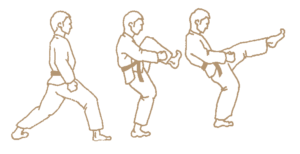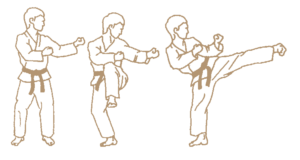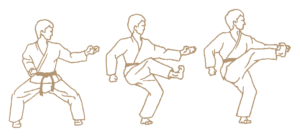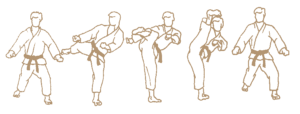Kicking differentiates the martial arts from other styles of fighting. The world of martial arts has many different types of kicks. There are spinning, jumping and flying kicks. Some kicks strike an attacker in the shins, and others strike him in the head. Before attempting more challenging kicking techniques, it is a good idea to understand the basic kicks.
Caution: Incorrect kicking techniques long term can have bad impact on your knees, and cause other injuries. I cannot stress how important it is to do your Keri Waza (kick techniques) with structure and patience.
For optimum effect a Karate kick relies on flexibility, a stable stance and good balance. The ball and the edge of the foot, the heel and the instep are all used as striking surfaces when kicking. Karate kicks are delivered with one foot on the floor or both feet in the air.
Key Features when kicking:
- Bring the leg back
- Control of the knee
- Direction of the standing leg
- Position of hips
- Stability and balance before, during and after the kick
- Target and Speed
More important than the actual kick is the return path and landing. Even if a Karate kick reaches its target, it will lack destructive power if it is not withdrawn sharply. This “pull back” (hiki ashi) creates power in the same way as a whip does. It also gets the leg back under the kickers control and safely out of the opponents range.
Understanding some basic kicks
Front Kick
The front kick is widely used in the martial arts. To execute this kick, raise your knee and point it at your target. Extend your leg and kick the target with the ball of your foot. Retract your leg after kicking the target. You can perform the kick in a snapping (Keage) or strong, thrusting (Kekomi) motion. A prime target for the front kick is an opponent's solar plexus. You can also kick an attacker in the groin by using the instep of your foot while executing this technique. The front kick in snapping motion can also be used to set an opponent up for additional kicks or punches.

Front kick with thrust (Mae-geri kekomi).
Side Kick
The side kick is another popular kick in the martial arts. Turn your body sideways to your target to perform the side kick. Lift your knee and kick straight out to your side with the bottom of your heel. Keep your kicking foot approximately parallel to the floor. You can perform the side kick in a snapping or strong, thrusting motion. You can effectively stop an oncoming attack by driving your side kick into an opponent's midsection. If you are flexible enough, you can deliver a side kick to an opponent's head. Sometimes the outside edge of the foot is used to hit a target when executing a side kick.

Side kick with thrust (Yoko-geri kekomi).
Crescent Kick
The crescent kick can be used as an offensive or defensive manoeuvre. To perform the crescent kick, lift your left knee up in front of you. Kick with your left foot in a circular, clockwise motion. Hit a target with the inside edge of your left foot. If you execute a crescent kick with your right foot, then kick in a counter clockwise direction. Hit a target with the inside edge of your right foot. A prime target for the crescent kick is an opponent's head. Defensively, you can use a crescent kick to block an oncoming attack. For example, if an attacker thrusts a stick at you, you can knock the weapon to the side by kicking the attacker's hand.

Crescent kick (Mikazuki-geri).
Reverse-Crescent Kick
The reverse-crescent kick is just the opposite of the crescent kick. Raise your left knee in front of you. This time, kick with your left foot in a counter clockwise motion. Hit the target with the outside edge of your left foot. On the right side, kick in a clockwise motion and hit with the outside edge of your right foot. The reverse-crescent kick is typically delivered to an opponent's head. This is a fast, powerful technique that can be difficult to block. Your opponent may think it is going in one direction, when suddenly it hits her on the side of the head from the other direction. Like the crescent kick, the reverse-crescent kick can also be used to block oncoming attacks.
Roundhouse Kick
The roundhouse kick is visually impressive. Stand positioned with your left shoulder toward your opponent. Your right knee comes up and out to the side and you pivot on your left foot. Snap your right foot out and strike with your right foot. Refold your right leg and pivot back to your initial stance with your left shoulder facing the opponent.

Extensive roundhouse kick (Mawashi-geri).
Keri can be separated into 4 Karate Kick Categories:
- Basic Kicks
- Advanced Kicks
- Advanced Leg Attacks
- Non-Traditional Kicks
Keri (Kick)
| Japanese | Pronunciation | Kanji | English |
|---|---|---|---|
| Keri | keh-ree | 蹴 | Kick |
| Ashi-barai | ah-she bah-rye | 足払 | Leg Sweep |
| Fukubu-geri | foo-koo-boo geh-ree | 腹蹴 | Abdomen Kick |
| Hiza-geri | hee-zah geh-ree | 膝蹴 | Knee Kick |
| Keage | key-ah-gay | 蹴上 | Snap |
| Kekomi | key-ko-mee | 蹴込 | Thrust |
| Kin-geri | keen geh-ree | 金的蹴 | Groin Kick |
| Mae-geri | my-geh-ree | 前蹴 | Front Kick |
| Mae-geri-kakato | my-geh-ree kah-kah-toe | 前蹴踵 | Front Kick with the Heel |
| Maetobi-geri | my-toh-bee geh-ree | 前飛蹴 | Flying Front Kick |
| Mawashi-geri | mah-wah-she-geh-ree | 廻蹴 | Round-house Kick with Top of Foot |
| Mikazuki-geri | mee-kah-zoo-key geh-ree | 三日月蹴 | Crescent Kick |
| Nidan-geri | nee-dahn geh-ree | 二段蹴 | Flying Front Kick, Two-level Kick |
| Sokuto-geri | soh-koo-tow geh-ree | 足刀蹴 | Foot-edge Kick |
| Ura mawashi-geri | oo-rah mah-wah-she geh-ree | 裏廻蹴 | Back Roundhouse Kick |
| Ushiro-geri | oo-she-row-geh-ree | 後蹴 | Back Kick |
| Yoko-geri | yoh-koh-geh-ree | 横蹴 | Side Kick |




